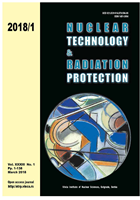
RADIOACTIVITY LEVEL AND CONCENTRATION OF METALS IN WATERS AROUND POWER PLANTS Application of Potential Method for Pollution Assessment
Pages: 117-124
Authors: Nataša B. Sarap, Jelena V. SenŠanski, Maja C. Pagnacco, Marija M. JankoviŠ,
Dragana J. TodoroviŠ, and Divna M. MajstoroviŠAbstract
Human activities may lead to increased levels of naturally occurring radioactive material and heavy metals in waters relative to undisturbed natural environment, consequently to reduced safety of environment. Therefore, evaluation of water quality from coal-fired power plants is essential to both environmental protection and protection of the human health. In this paper the concentrations of metals (K, Sr, and Pb) and corresponding radionuclides (40K, 90Sr, and 210Pb) for 22 water samples in the vicinity of five coal-fired power plants in Serbia were determined. The total metal concentrations were measured using an atomic absorption spectrometer. The activities of radionuclides 40K and 210Pb were determined by gamma spectrometry using HPGe detector, while the activity of 90Sr was determined by radiochemical analytical method and measured using low-level gas proportional counter. The water pollution status was assessed by the prospective method that is defined in this study. The preliminary results indicated that operation of the coal-fired power plants has no significant impact on the surrounding environment with regard to the radiological characteristics and content of metals of the investigated waters that can be used for suitable in future applications.
Key words: metal content, radionuclide, wastewater, pollution
FULL PAPER IN PDF FORMAT (815 KB)
